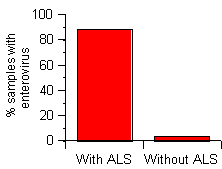 | Possible Link Between a Virus and "Lou Gehrig's Disease" |  |
 | Possible Link Between a Virus and "Lou Gehrig's Disease" |  |
| February 2, 2000 |
 ALS is also known as Lou Gehrig's Disease |
Able to think, unable to move. The mind trapped within the body.
That is how people with amyotrophic lateral sclerosis
(ALS) describe their condition. Their thinking abilities
including memory are working, but their bodies will not respond to
commands from the brain to move. ALS is also called "Lou Gehrig's
Disease" after the famous baseball player who died of the disorder in
1941. The National
Institutes of Health estimates that there are 14,000-15,000 people
in the United States with ALS. The ALS
Association estimates that there are 15 new cases of ALS are
diagnosed every day. ALS is caused when certain neurons in the motor cortex and spinal cord die. These neurons control voluntary muscles and the ability to move. As these neurons die, a person may become weak and paralyzed. ALS is not contagious, but it may run in families. There are several drugs to treat the symptoms of ALS, but there is no cure and the cause of this disorder is still unknown. Research published in the journal Neurology (January 2000) suggests that a virus may be responsible for ALS. |  Motor neuron in the spinal cord. |
| Scientists in the US, France and Austria collaborated to examine
the spinal cords of people who died with ALS and those from a control
group of people who died of other causes. The researchers were interested
to see if the spinal cord tissue from those people with ALS was infected
with an enterovirus. When the data were analyzed,
the virus was found in the tissue from 15 of 17 patients (88.3%) who had
ALS, but in the tissue of only 1 of 29 control patients (3.4%). These data suggest a link between the enterovirus and ALS. However, still unknown is how the virus gets into neurons and whether the presence of the virus is the cause of the disease or a result of the disease. If further research determines that the virus is a cause of ALS, then it is possible that anti-viral therapies could be developed to fight this disorder.
|  Spinal Cord Samples |
|
References and further information:
|
They said
it! | "I am quite often asked: How do you feel about
having ALS? The answer is, not a lot. I try to lead as normal a life
as possible and not think about my condition or regret the things it
prevents me from doing, which are not that many." --- Steven W. Hawking, 1973 (in Black Holes and Baby Universes and other Essays) |
| BACK TO: | Neuroscience In The News | Table of Contents |
![[email]](./gif/menue.gif) Send E-mail |
![[newsletter]](./gif/menunew.gif) Get Newsletter |
![[search]](./gif/menusea.gif) Search Pages |